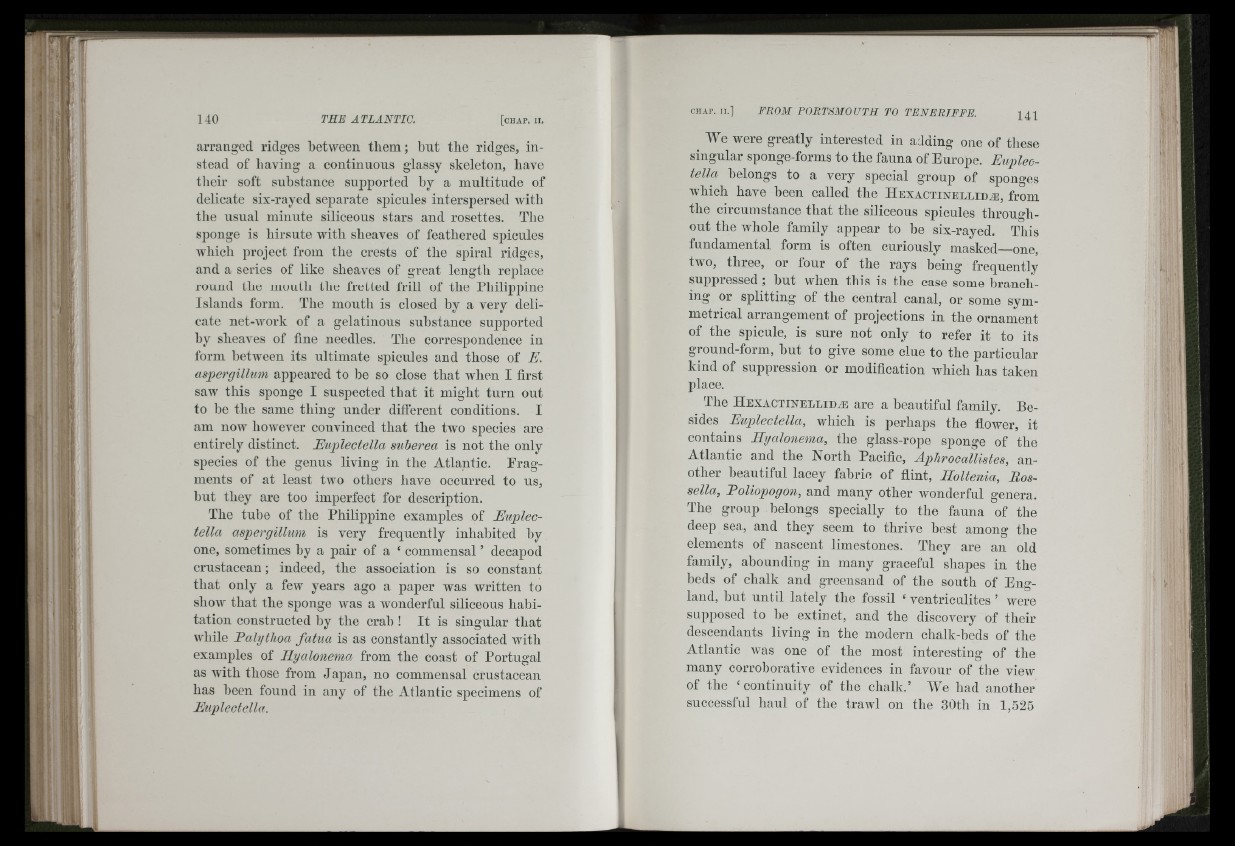
140 T H E A T L A N T I C . [ c h a p . II .
arranged ridges between them; but the ridges, instead
of having a continuous glassy skeleton, have
tlieir soft substance supported by a multitude of
delicate six-rayed separate spicules interspersed with
the usual minute siliceous stars and rosettes. The
sponge is hirsute with sheaves of feathered spicules
Avhich project from the crests of the spiral ridges,
and a series of like sheaves of great length replace
round the mouth the fretted frill of the Philippine
Islands form. The month is closed by a very delicate
net-Avork of a gelatinous substance supported
hy sheaves of fine needles. The correspondence in
form hetween its ultimate spicules and those of E.
aspergillum appeared to be so close that when I first
saAV this sponge I suspected that it might turn out
to he the same thing under different conditions. I
am noAV however convinced that the two species are
entirely distinct. Euplectella suberea is not the only
species of the genus living in the Atlantic. Fragments
of at least tAvo others have occurred to ns,
hilt they are too imperfect for description.
The tube of the Philippine examples of Euplectella
aspergillum is very frequently inhabited hy
one, sometimes hy a pair of a ‘ commensal ’ decapod
crustacean; indeed, the association is so constant
that only a fcAv years ago a paper was written to
shoAV that the sponge was a wonderful siliceous habitation
constructed hy the crah ! It is singular that
AAdiile Ealythoa fa tu a is as constantly associated Avith
examples of Hyalonema from the coast of Portugal
as with those from Japan, no commensal crustacean
has heen found in any of the Atlantic specimens of
Euplectella.
CHAP. I I .] F R O M P O R T S M O U T H T O T E N E R I F F E . 141
We were greatly interested in adding one of these
singular sponge-forms to the fauna of Furope. Euplectella
iDelongs to a very special group of sponges
AAdiich have heen called the Hexactinellid^ , from
the circumstance that the siliceous spicules tlirough-
out the whole family appear to be six-rayed. This
fundamental form is often curiously masked—one,
two, three, or four of the rays being frequently
suppressed ; but when this is the case some branching
or splitting of the central canal, or some symmetrical
arrangement of projections in the ornament
of the spicule, is sure not only to refer it to its
gronnd-form, hut to give some clue to the particular
kind of suppression or modification which has taken
place.
The Hexactinellid^ are a beautiful family. Besides
Euplectella, which is perhaps the flower, it
contains Hyalonema, the glass-rope sponge of the
Atlantic and the North Pacific, Aphroeallistes, another
heautiful lacey fabric of flint, Holtenia, Bos-
sella, Poliopogon, and many other Avonderful genera.
The group belongs specially to the fauna of the
deep sea, and they seem to thrive best among the
elements of nascent limestones. They are an old
family, abounding in many graceful shapes in the
beds of chalk and greensand of the south of Fng-
land, but until lately the fossil ‘ ventriculites ’ were
supposed to be extinct, and the discovery of their
descendants living in the modern cbalk-beds of the
Atlantic was one of the most interesting of the
many corroborative evidences in favour of the vicAV
of the ‘ continuity of the chalk.’ We had another
successful haul of the trawl on the 30th in 1,525
I i . .
• \